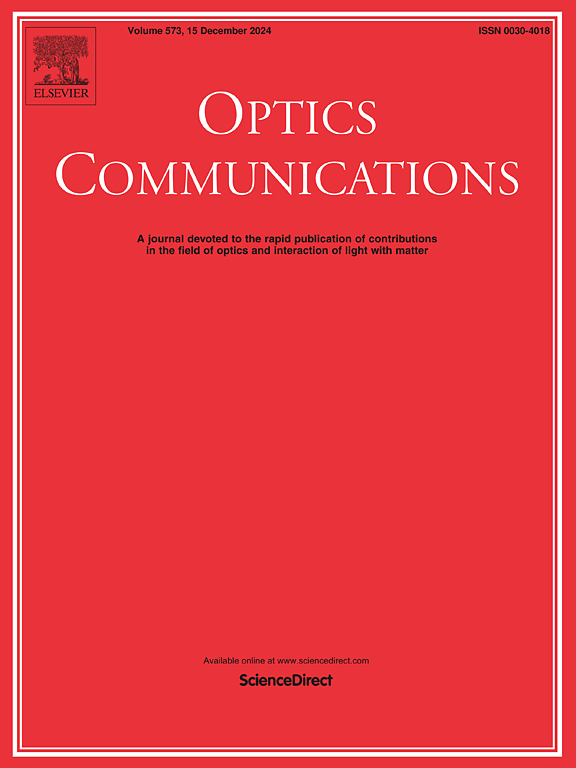High-Q coupled topological edge state in 1D photonic crystal mirror heterostructure for ultrasensitive thermal sensing
IF 2.2
3区 物理与天体物理
Q2 OPTICS
引用次数: 0
Abstract
This work explores a novel 1D topological photonic crystal (PC) mirror heterostructure for high-performance thermal sensing. The design leverages a unique coupled topological edge state mode (CTES) exhibiting exceptional light confinement at the interface, characterized by a record-high quality () factor. The study investigates the effects of nematic liquid crystal (NLC) integration and temperature variations to enhance functionality. Two NLC defect configurations are explored: complete replacement of silica layers and localized replacement within one topological PC. In both scenarios, the CTES mode exhibits tunability in frequency and factor due to the thermo-optic properties of the NLC. This dynamic control offers advantages for various applications beyond thermal sensing, including filtering and switching. The first NLC configuration achieves an outstanding factor of , surpassing the intrinsic value. Additionally, it demonstrates exceptional thermal sensitivity (−0.12317 nm/°C) and a remarkable figure of merit (1002.48 ). These superior sensing characteristics are attributed to the strong light localization at the interface and the intensified light-matter interaction facilitated by the NLC. The second configuration offers a trade-off between sensitivity and tunability, exhibiting a factor in the range, a sensitivity of −0.05853 nm/°C, and a figure of merit of 86.53 . This study presents a groundbreaking design for 1D topological PC mirror heterostructures with integrated NLC. This platform holds immense promise for developing high-performance, tunable narrowband filters and ultrasensitive thermal sensors, paving the way for advancements in diverse photonic applications.
用于超灵敏热感应的一维光子晶体镜面异质结构中的高 Q 值耦合拓扑边缘态
这项研究探索了一种用于高性能热传感的新型一维拓扑光子晶体(PC)镜面异质结构。该设计利用独特的耦合拓扑边缘态模式 (CTES),在界面上表现出卓越的光局限性,并以创纪录的高品质因数 (Q) 为特征。研究调查了向列液晶 (NLC) 集成和温度变化对增强功能的影响。研究探讨了两种 NLC 缺陷配置:硅层的完全置换和一个拓扑 PC 内的局部置换。在这两种情况下,由于 NLC 的热光学特性,CTES 模式都表现出频率和 Q 因数的可调性。这种动态控制为热感应以外的各种应用提供了优势,包括滤波和开关。第一种 NLC 配置实现了 107 的出色 Q 因子,超过了固有值。此外,它还表现出卓越的热灵敏度(-0.12317 nm/°C)和显著的优点系数(1002.48 °C-1)。这些卓越的传感特性归功于界面上的强光定位以及 NLC 所促进的光-物质相互作用的增强。第二种配置在灵敏度和可调性之间进行了权衡,其 Q 值在 106 范围内,灵敏度为 -0.05853 nm/°C,优点系数为 86.53 °C-1。这项研究提出了集成 NLC 的一维拓扑 PC 镜异质结构的突破性设计。这一平台为开发高性能、可调谐窄带滤波器和超灵敏热传感器带来了巨大前景,为各种光子应用的进步铺平了道路。
本文章由计算机程序翻译,如有差异,请以英文原文为准。
求助全文
约1分钟内获得全文
求助全文
来源期刊

Optics Communications
物理-光学
CiteScore
5.10
自引率
8.30%
发文量
681
审稿时长
38 days
期刊介绍:
Optics Communications invites original and timely contributions containing new results in various fields of optics and photonics. The journal considers theoretical and experimental research in areas ranging from the fundamental properties of light to technological applications. Topics covered include classical and quantum optics, optical physics and light-matter interactions, lasers, imaging, guided-wave optics and optical information processing. Manuscripts should offer clear evidence of novelty and significance. Papers concentrating on mathematical and computational issues, with limited connection to optics, are not suitable for publication in the Journal. Similarly, small technical advances, or papers concerned only with engineering applications or issues of materials science fall outside the journal scope.
 求助内容:
求助内容: 应助结果提醒方式:
应助结果提醒方式:


